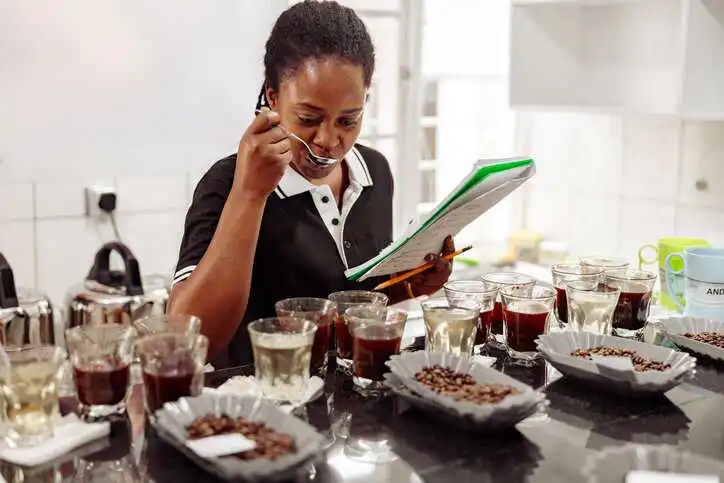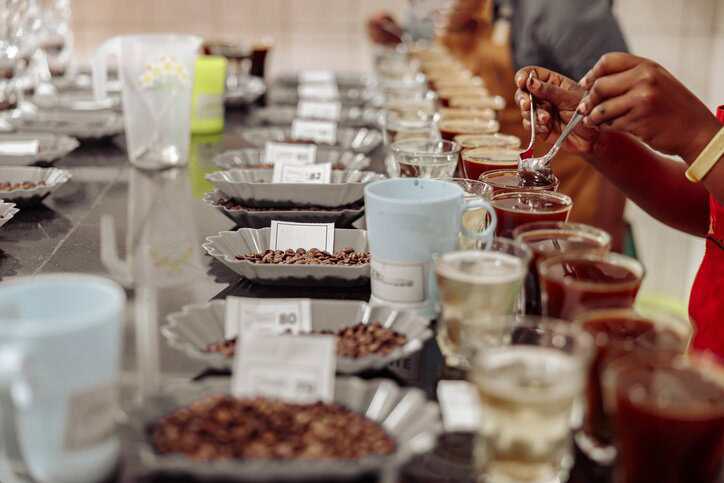ISO 18794:2018—Coffee Sensory Analysis Vocabulary

Rather than beans, coffee beans are actually considered seeds of the coffee cherry fruit. Growing on tall shrubs and bushes that resemble a berry bush, the coffee cherry is a small fruit that contains a hard and bitter skin with juicy and sweet flesh. Underneath the flesh is an undesirable layer that typically feels a bit slimy, but it is necessary to protect the coffee bean inside. ISO 18794:2018—Coffee – Sensory analysis – Vocabulary defines terms relating to coffee sensory analysis.
What Is Inside the Coffee Cherry?
Upon picking a coffee cherry and removing its husk, you will find an inner layer of pulp. After peeling the pulp apart, you will see either two coffee seeds with flat sides (that look like typical coffee beans) or one single round bean also referred to as a peaberry. Less than 10% of all coffee cherries contain a peaberry, which is the result of natural mutation from not having to share its nutrients with a twin. It is much more common for the fruit to produce two flat beans as opposed to the peaberry bean, which has a unique flavor with notes of fruitiness, floral undertones, and a bright acidity.
Regardless of whether there is one seed or two, each bean gets removed from the fruit, dried out, and roasted. At this point the beans can be grinded, allowing a user to make a cup of coffee with them.
What Is ISO 18794?
ISO 18794:2018 covers definitions applicable to green, roasted and ground coffee, coffee extracts, and soluble coffee. The terms are given under the following headings:
- Basic terms of sensory analysis
- Generic terms in the sensory assessment of coffee
- Terminology relating to coffee-specific odors and tastes
- Terms commonly used in sensory assessment of coffee by practitioners

When Did Coffee Become a Morning Beverage?
Coffee’s rise as a morning beverage staple in America is linked to the American Revolution. During the colonial era, particularly following the Boston Tea Party in 1773, coffee started to gain popularity. As tensions between the American colonies and Britain escalated, drinking tea—a symbol of British taxation—was seen as unpatriotic. Coffee, on the other hand, became a symbol of resistance and independence.
The American Revolution further solidified coffee’s place in American society. With tea imports disrupted by the war, colonists turned to coffee, boosting its demand and encouraging the growth of the coffee trade. By the end of the 18th century, coffee had firmly established itself in the hearts and cups of Americans.
The Importance of Evaluating Sensorial Qualities in Coffee
Sensory analysis examines the properties (texture, flavor, taste, appearance, smell, etc.) of a product or food, such as coffee, through the senses (sight, smell, taste, touch and hearing) of industry professionals. By conducting sensory evaluations, industry professionals can identify and address any potential issues in the coffee’s aroma, taste, and appearance, assuring that the final product meets their high standards. The use of sensory analysis helps to validate the final quality of the coffee.
ISO 18794:2018—Coffee – Sensory analysis – Vocabulary is available on the ANSI Webstore.






